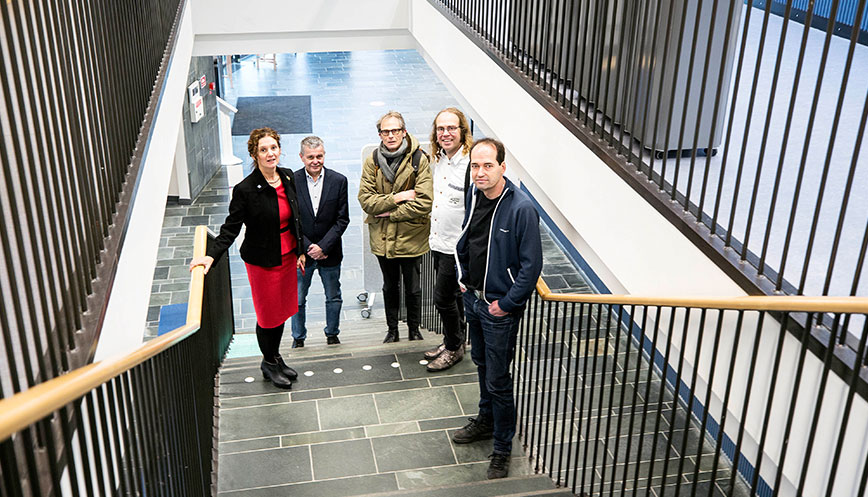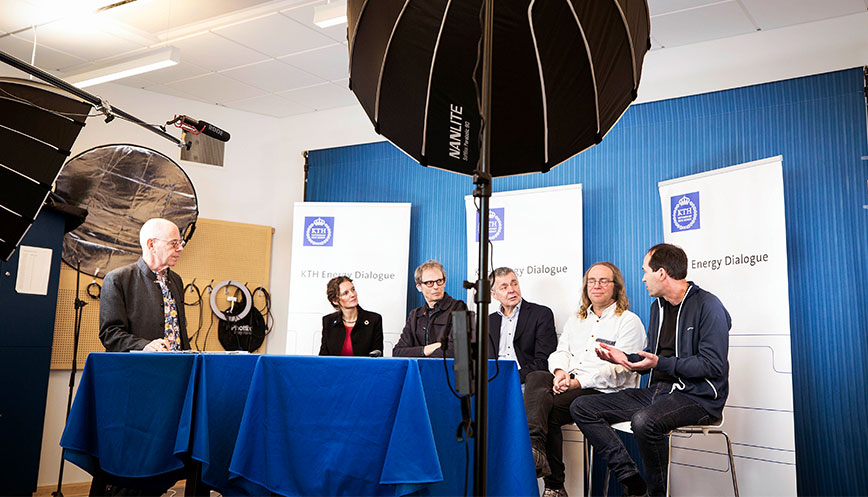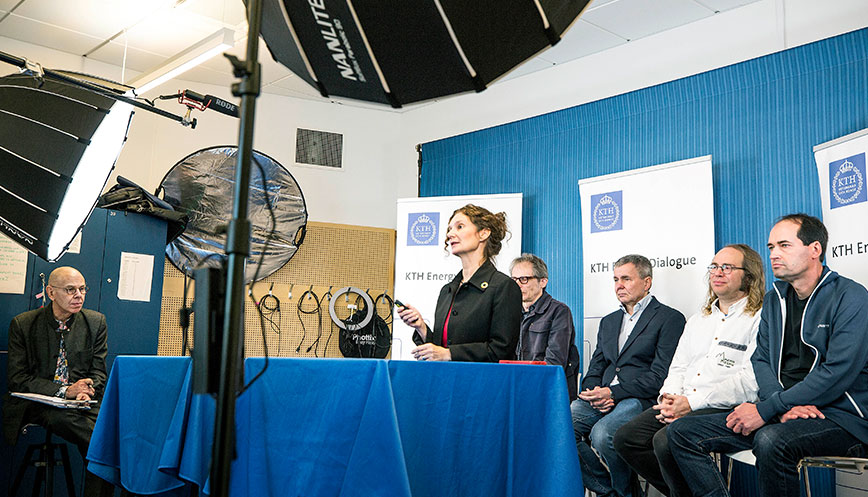Future energy supply will be based on more informed debate

The last KTH Energy Platform seminar of the year, held on 16 December, addressed the question of how the energy sector can most effectively address the ongoing climate transition. Insights were provided into the role of wind and nuclear power in that transition and how district heating can be used more effectively than it is today. The panel called for a mix of complementary energy sources, and more knowledge about and greater acceptance of different energy sources.
During the seminar, more than 100 people participated digitally and discussions were led by moderator Willy Silberstein. The seminar was attended by Erik Dotzauer, responsible for policy issues at Stockholm Exergi; Janne Wallenius, professor of reactor physics, KTH; Lennart Söder, professor of electrical energy systems, KTH; Lina Bertling Tjernberg, professor of electric power grids, KTH; and Filip Johnsson, professor of energy technology, Chalmers University of Technology.
District heating has the potential to balance the energy mix
Dotzauer opened the seminar by highlighting the link between district heating and the electricity system.
“The district heating system can be used more effectively to balance the electrical system when necessary. We can switch between producing and consuming electricity depending on the price of electricity, among other things. In addition, we can use waste heat from data halls and industry,” said Dotzauer.
Dotzauer described how the Värtaverket power plant has been transformed into a facility that supplies electricity with the help of biofuels when Stockholm’s energy needs peak. In the future, there will be times when it will be necessary to increase the city’s power supply, for example due to a lack of transmission capacity.
The second speaker was Janne Wallenius from KTH.
“Nuclear power is the most carbon-efficient energy source we have in Sweden, so obviously it can help address the climate issue. The problem is that large nuclear power plants take a long time to build,” said Wallenius.
The costs and long construction times of large nuclear power plants have turned attention to small modular reactors, (SMRs). SMRs are designed to be series produced, using modular factory fabrication, and then installed on site. The idea is that it takes two to three years to build an SMR.
SMRs and climate goals
SMR technology has been talked about for many years and is now being introduced in a number of countries, for example Russia.
“The SMR revolution is happening right now. Forecasts suggest that SMRs could contribute 1,000 GW of power globally and this will make a significant contribution to achieving climate goals. Higher electricity prices in the future will make it commercially viable to build new nuclear power plants in Sweden,” said Wallenius.
KTH’s Sunrise research project is underway with the goal of developing a demonstration reactor by 2030 ahead of future scale production.
“The risks associated with SMR technology are primarily financial and not technical. SMR plants contain about 20 times less radioactive fuel than existing facilities and are designed so that no one outside an SMR needs to be evacuated in the event of a meltdown. A political decision is needed to change the law on the number of nuclear power plants that are permitted in Sweden. If we see a change of government, this could happen quickly; although I think that the (incumbent) Social Democrat government will also take up this issue,” said Wallenius.

Wind power features in all forecasts
Lennart Söder, professor of electrical energy systems at KTH, started by providing details of the costs associated with different sources of power in Sweden.
“In 2006-2007, nuclear power was seen as a cheap solution on the assumption that it produced electricity at a cost of 30 öre per kilowatt hour. Since then, nuclear power has risen in price substantially, to more than one krona per kilowatt hour,” Söder said.
Meanwhile, wind power has gone in the opposite direction and has become increasingly cheaper, he added. Today, analysts predict that electricity from wind will cost about 40 öre per kilowatt hour by 2030, while nuclear power will exceed one krona.
This is due to the considerable uncertainty associated with the construction of new nuclear power plants, Söder explained, adding that calculations show that the cost of building a new nuclear power plant is about SEK 30 billion higher than the equivalent capacity in wind power to meet projected energy demand by 2045.
He also emphasized that wind power features in all future projections as a significant power source. And projects like Hybrit will help make it easier to stabilize the electricity supply due to new technologies and hydrogen storage.
This should form the basis of any discussion we have about adaptable power supply, Söder said.
Currently, there are wind power projects totalling 200 TW hours in Sweden with investors waiting for permits. Nuclear power faces fierce competition from wind power in terms of production price and permit procedure, he said.
“If we’re to increase capacity in the immediate future, there are a large number of wind power projects ready in place; [wind power] is cheap, and the global commercial development of wind power is set to surge dramatically.”
Greater flexibility in the future
Filip Johnsson, professor of energy technology at Chalmers University of Technology, presented a snapshot of the transformation of the energy system. In the past, the energy system has evolved in isolation from other sectors. As we approach the climate transition, however, the energy sector needs to align with other parts of the economy.
“A future in which climate goals are achieved will include large amounts of unplanned electricity production, especially wind power production. This means that we need to become more flexible in our use of electricity,” Johnsson said.
This demands co-ordination between sectors with smart charging of electric vehicles and hydrogen solutions for industry. In addition, solutions are needed to meet peaks in consumption together with adapted use of electricity over time.
“Transmission connections are a way to create flexibility and therefore we need to build greater transmission capacity. Looking ahead, it’s not only relevant how we produce electricity, but also how we use it,” he said.
“The main challenge is to create acceptance for the transition. I do not see any technical problem in achieving climate goals. Rather, the problems lie in today’s long approvals process.”
Lina Bertling Tjernberg also contributed with perspectives from the point of view of the energy system.
“Knowledge should be our starting point prior to major change, and we need an international perspective to our discussions,” Bertling Tjernberg said.
She went on to emphasize that the purpose of the transition is to achieve the UN Sustainable Development Goals. Changes to production and an increase in electrification are two key factors in this process. Among the challenges facing the electricity grid of the future are an increased need for flexibility, lack of capacity and new market solutions where consumers also become electricity producers. The electricity network is extremely complicated and Sweden was among the first in the world to build smart electricity networks. A lot has happened since then, but not enough, she said.
“Electrification, digitalisation and the circular economy are trends that are changing society. In the circular economy, it will be important to reuse materials, including batteries,” she added.
The development of the electrical system also includes a more intelligent and adaptable network, a flexible network infrastructure and improved components with environmentally friendly solutions.
Growing needs for skills
Bertling Tjernberg also commented on the national electrification strategy to which the Energy Platform at KTH contributed in several ways during the year. It focuses on the need for increased knowledge about the capacity of electricity grids, the expansion of the power grid to avoid bottlenecks, and the need for increased competence with greater focus on training.
“One way to quickly increase transmission capacity is to increase network voltage, which has been done in Norway, for example. We would like to investigate in more detail how this can be done without, for example, causing interruptions,” Bertling Tjernberg said.
Existing models for the expansion of power grids fail to sufficiently reflect the value of new infrastructure as it is added.
“This is a classic mistake as experience shows how new infrastructure quickly becomes well-used and valuable. Expanded infrastructure represents a valuable addition to society as a whole that is not shown in today’s models,” she said.
The panel debate at the end of the seminar was at times tough when discussion focused on the benefits of wind and nuclear power.

The panel debate at the end of the seminar was at times tough when discussion focused on the benefits of wind and nuclear power. Photo credit: Håkan Lindgren
Closing panel debate
The cost of expanding nuclear power was one of the issues discussed during the concluding panel debate.
“Even with SMRs, we’re unlikely to see less than 60 öre per kilowatt hour; however, studies say that nuclear power is needed to create the most cost-effective electricity system,” Wallenius said.
Lennart Söder criticized studies that formed the basis for this conclusion and said that we need to see which type of technology will give Sweden a competitive advantage internationally.
“Our challenge is to be competitive in the global market place. We currently have good conditions for wind power while SMRs can be built here in Sweden as well as anywhere else in the world,” Söder said.
Bertling Tjernberg said that the choice between energy types is a challenge that the market will solve.
“The problem is that we have not expanded infrastructure sufficiently and that limits today’s market,” she said.
Söder backed this view and argued that the market was already paving the way for companies that contribute to smarter electricity use with technologies that automatically control heating and electric vehicle charging.
“Awareness of the climate issue continues to grow. This is driving debate about improved infrastructure and increasing electricity demand. Now the industry itself is also talking about its growing electricity needs,” Söder said.
Calls for simpler processes
The panel ended with questions from viewers, which sparked an at times heated debate about differences in the system cost for different types of power, what factors affect the price of electricity in the future, and how we best adapt planning to this end.
“When we remove bottlenecks to transmission capacity, technology offers ways to transform today’s market. First, we need to eliminate technical problems,” Bertling Tjernberg said.
Necessary changes to laws and regulations also came up during the panel debate.
“Permit processes need to be clearer to prevent appeals. And we need to find ways to reach compromises between different environmental goals, in part to provide more offshore wind power,” Johnsson said.
Politicians should focus on what really slows progress instead of spending time pitting different forces against each other, Johnsson argued.
The future promises the development of technologies that contribute to more predictable power supply, including batteries, heat pumps, hydrogen storage, electric vehicles and district heating plants.
“The country’s district heating plants already have significant capacity that is not fully utilized. Here is an opportunity to use excess heat to create space for electricity production as well,” Dotzauer said.

Bertling Tjernberg brought the seminar to a close.
“Today’s seminar clearly shows that we need a mix of complementary technologies and a fact-based debate, leading to a new agreement in energy policy,” she said.
Text: Magnus Trogen Pahlén

